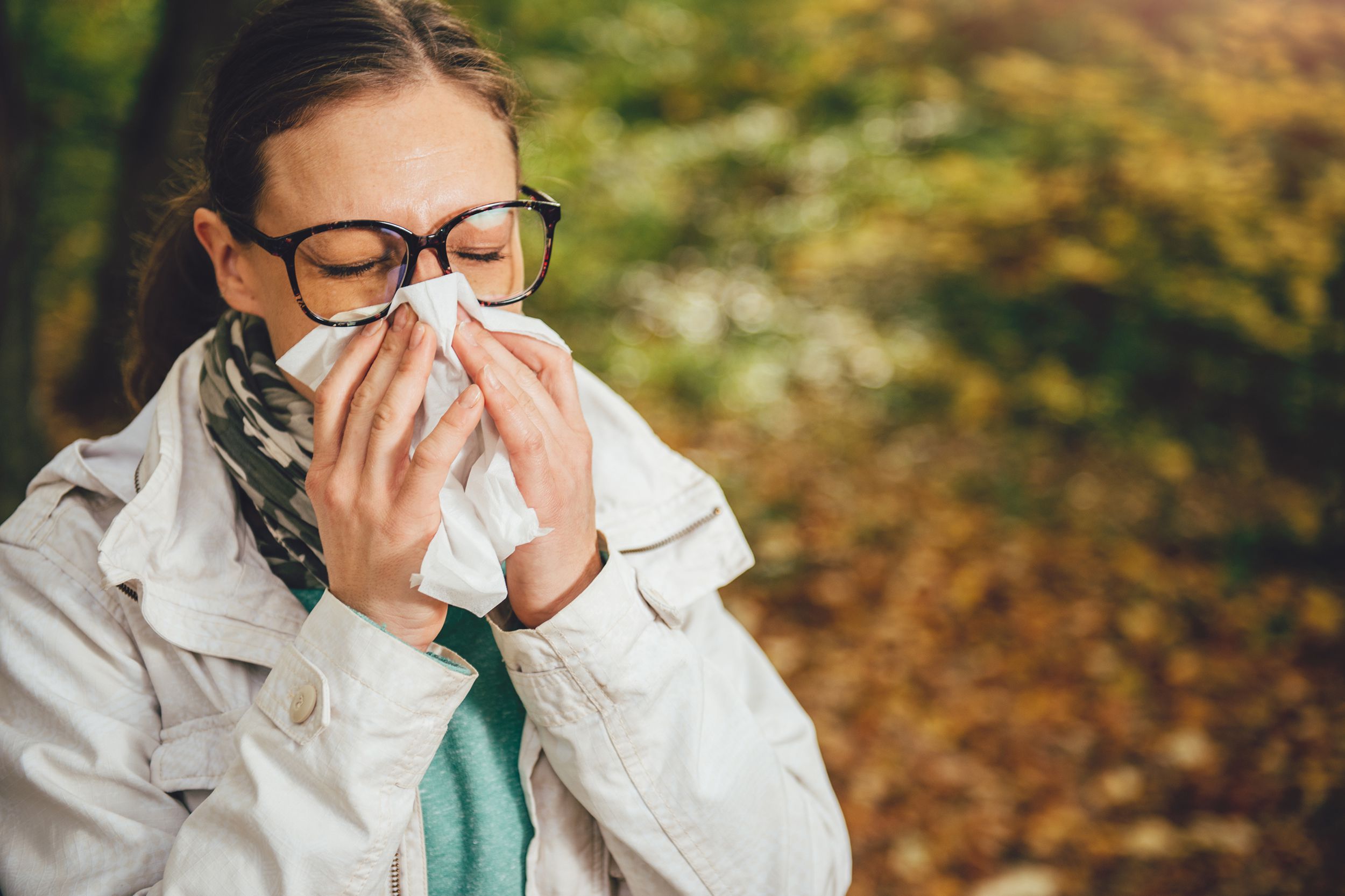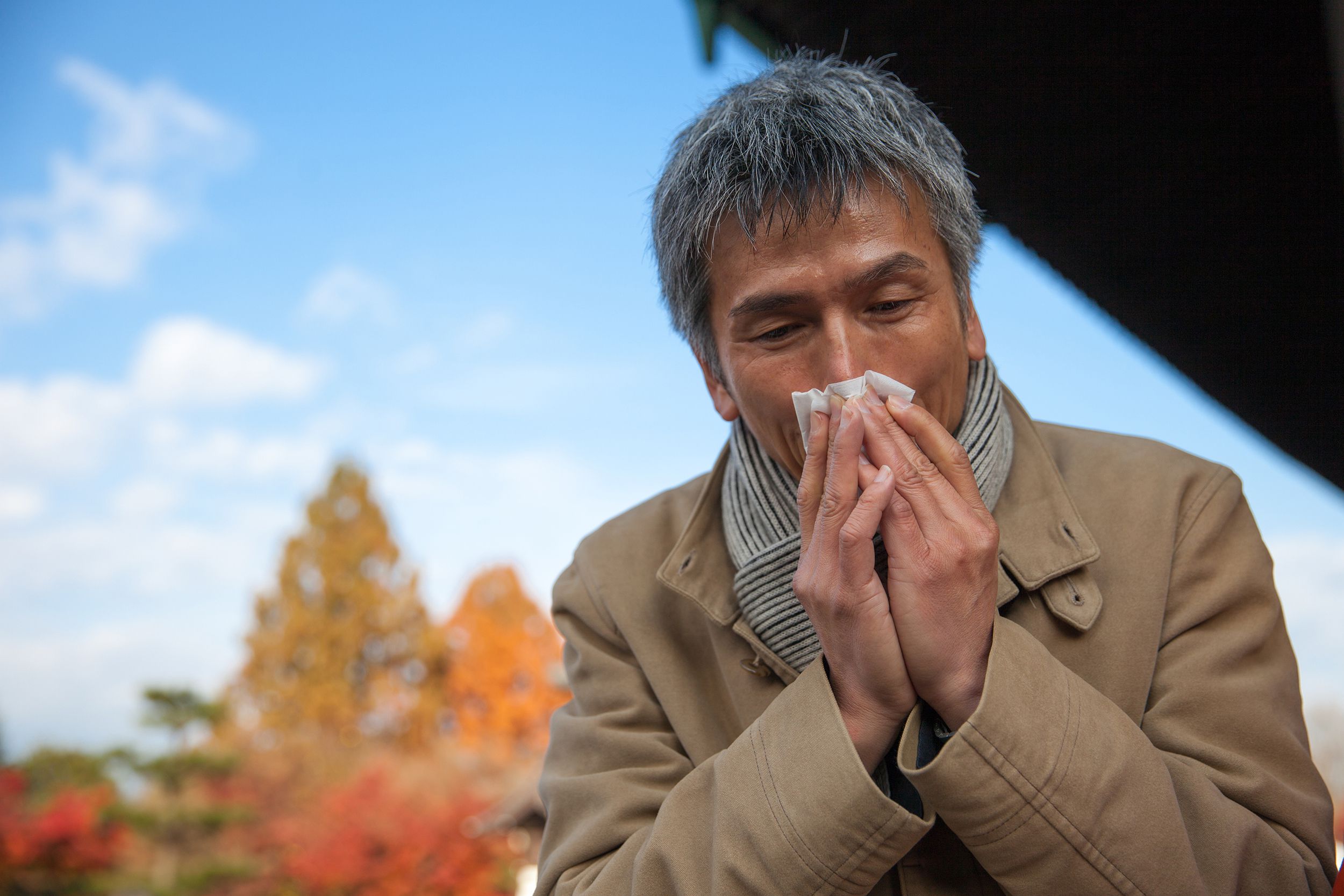Allergies have been growing in prevalence over the past few decades, particularly in Western nations. And while allergies among children often receive the lion’s share of attention, the reality is that many adults suddenly find themselves dealing with allergies they did not have earlier in life. One study found, for instance, that that almost half of the grown-ups with food allergies had developed at least one of their allergies in adulthood. Here’s a closer look at the issue of adult-onset allergies and the various types of allergies one might suddenly find themselves dealing with later in life.
Related: 11 Steps to Combating Fall Allergies
What Causes an Allergy?

As a recent BBC article noted, allergies are caused by the immune system fighting substances in the environment that it should view as harmless. These substances are known as allergens. When innocuous substances become targets of the immune system, it triggers an allergic reaction.
Related: 15 Weird Ways Your Body Is Telling You to Go to the Doctor
Types of Allergic Reactions

Your body can produce a variety of allergic reactions, including symptoms that are uncomfortable but not dangerous, like itchy skin and diarrhea. On the other end of the spectrum, anaphylaxis is an allergic reaction that is potentially life-threatening.
What Is Anaphylaxis?

A severe and sometimes life-threatening allergic reaction, anaphylaxis can occur within seconds or minutes of exposure to something you are allergic to. During anaphylaxis the human body overreacts to the allergenic substance. The individual can suffer a variety of extreme symptoms in different parts of the body at the same time such as a sudden drop in blood pressure, airways narrowing, nausea, and vomiting.
Food Allergies Have Been Increasing

Studies have found that food allergies have been increasing over the past 30 years. Currently, the Food and Drug Administration officially recognizes eight allergenic foods. These include milk, eggs, fish, shellfish, tree nuts (including walnuts), peanuts, wheat, and soybean. A study conducted by researchers from Ann & Robert H. Lurie Children’s Hospital of Chicago and Northwestern University found that almost half of the adults with food allergies had developed at least one of their allergies in adulthood. Researchers have expressed surprise that adult-onset food allergies are so common.
Most Common Food Allergies Among Adults

When researchers looked at the specifics of food allergies among U.S. adults, they found the most common to be shellfish, milk, peanuts, tree nuts, fin fish, eggs, wheat, soy, and sesame. Shellfish in particular is the top food allergen in adults and shellfish allergy commonly begins in adulthood. “Shellfish allergy is more likely to develop in adulthood. Risk factors for development are the use of alcohol as well as antacids, which, over time, can change the pH of our stomachs and impact the way shellfish protein is broken down, making it, in some people, look foreign and trigger an allergic response,” said Dr. Tania Elliott, a board-certified allergist. “It is best to avoid alcohol and overuse of antacids when possible.”
Trending on Cheapism
Dining Out When You Have Food Allergies

When it comes to living with food-related allergies, check for allergy-friendly restaurants, and let your waiter know up-front that you have an allergy, Elliott says. In addition, it’s a good idea to ask if the restaurant staff has taken a course in food allergy prevention and treatment. There is no cure for food allergies. Managing the condition is the primary way to address this challenge and relies on avoiding the offending foods and having an emergency treatment plan in the event of an exposure.
Adults Can Develop More Than Just Food Allergies

Food allergies aren’t the only issues adults face. Elliott said adults can also develop environmental allergies. “For environmental, people typically can develop allergies until about age 40,” Elliott said. “Common allergies include tree pollen, grass pollen, weed and ragweed, cat and dog, dust mites, and mold.” Adults are more likely to develop allergies within six to 12 months of moving to a new location with a different climate, Elliott said.
Related: The Best and Worst Cities for Allergy Sufferers
Spice Allergies

Though very rare, yet another allergy that can develop among adults is spice allergy, Elliott said. “We see it in up to 2 percent of adults, likely because as we get older we start to introduce new types of foods into our diet,” Elliott said.
Sign up for our newsletter
Drug Allergies

Adults, who tend to get placed on more medications as they age, can also develop drug allergies, says Dr. Princess Ogbogu, director of allergy and immunology for the Ohio State University Wexner Medical Center. “This can develop at any time in life,” Ogbogu said. “There is no data on how it might be prevented.”
Related: How to Safely Clean Out Your Medicine Cabinet
Contact Dermatitis

Another common adult onset allergy is contact dermatitis, according to Dr. Paul Harrison, a dermatologist and allergist with TrueSkin Dermatology. “This specific kind of allergy is triggered through direct contact of the allergen to the skin and typically results in a dry, scaly, red, and itchy rash which looks similar to eczema,” Harrison said. With allergic contact dermatitis, an itchy rash can develop up to several days after the exposure and skin contact, he said. Examples of allergic contact dermatitis include rashes from poison ivy, metals, gloves, rubber elastic, glues, makeup, shampoo, hand lotions, nail polish, acrylic nails, clothing, waterless cleansers, and over-the-counter medicines and prescriptions creams.
How to Respond to Contact Dermatitis

Allergic contact dermatitis commonly persists and recurs without rhyme or reason, Harrison said. Treatment typically involves a visit to a dermatologist and sometimes skin allergy testing, called patch testing, to detect what’s causing the skin allergy. “Once the patient identifies the allergen, then they can read ingredients of all creams, lotions, and topical medications to avoid new contact with the allergy-causing irritant,” Harrison said. “With avoidance, caution, and allergy-free medicines or treatment, patients can get relief and have hope to live rash free.”
Related: 14 Health Problems You’re Not Getting Help For — But Should
Allergic Rhinitis

Allergic rhinitis or hay fever is another challenge that commonly occurs in adulthood after several spring or fall exposures, said Dr. Dean C. Mitchell, a board-certified allergist with 25 years of clinical experience who runs Mitchell Medical Group. Allergic rhinitis triggers cold-like signs and symptoms, including runny nose, itchy eyes, congestion, sneezing, and sinus pressure. It’s caused by a variety of allergens, such as pollen, dust mites, and pet dander. Colds, on the other hand, are caused by viruses.
Related: 16 Steps to Combat Spring Allergies
Mistaken Allergies

Not everyone who thinks they have an allergy is correct about that. While millions of people do live with food allergies for instance, many more people mistakenly believe they suffer from such an allergy, according to the study conducted by researchers from Ann & Robert H. Lurie Children’s Hospital of Chicago and Northwestern University. The study found that almost 1 in 5 adults in the United States think that they have a food allergy, but in reality, only about 1 in 10 actually do.
Those Allergies May Actually Be Due to Other Conditions

Dr. Ruchi Gupta, head of the research team that led the study for the Ann & Robert H. Lurie Children’s Hospital of Chicago and Northwestern University, said many people may begin to fear that they are allergic to a food when their reactions are, in fact, due to other conditions. According to Gupta, “It is important to see a physician for appropriate testing and diagnosis before completely eliminating foods from the diet.”
Related: 12 Surprising Symptoms of Health Problems That Could Cost Thousands






